Adding GraphQL Support to Loco with Seaography
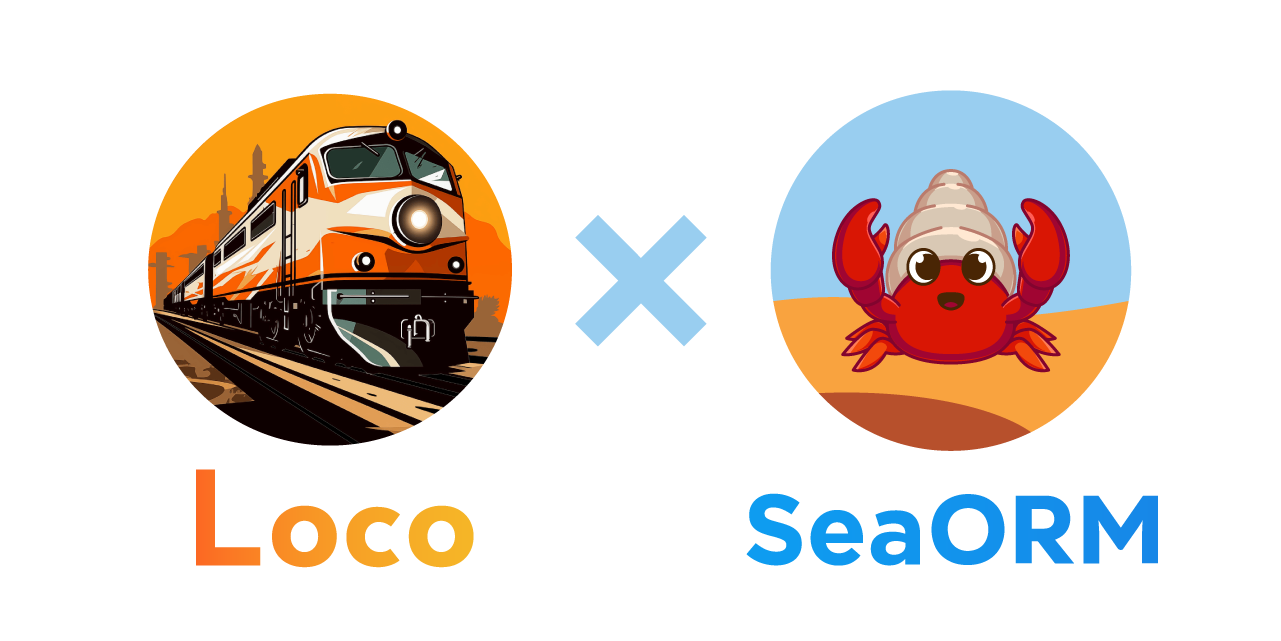
In this tutorial, we would add a GraphQL endpoint with Seaography based on our Loco starter application. Read our first tutorial of the series, Getting Started with Loco & SeaORM, if you haven't.
The full source code can be found here.
What is Seaography
Seaography is a GraphQL framework for building GraphQL resolvers using SeaORM entities. It ships with a CLI tool that can generate ready-to-compile Rust GraphQL servers from existing MySQL, Postgres and SQLite databases.
Adding Dependency
Modify Cargo.toml and add a few more dependencies: seaography, async-graphql, async-graphql-axum and lazy_static.
seaography = { version = "1.0.0-rc.4", features = ["with-decimal", "with-chrono"] }
async-graphql = { version = "7.0", features = ["decimal", "chrono", "dataloader", "dynamic-schema"] }
async-graphql-axum = { version = "7.0" }
lazy_static = { version = "1.4" }
tower-service = { version = "0.3" }
Setting up SeaORM Entities for Seaography
Seaography Entities are basically SeaORM Entities with some additions. They are fully compatible with SeaORM.
You can generate Seaography Entities by using sea-orm-cli with the extra --seaography flag.
sea-orm-cli generate entity -o src/models/_entities -u postgres://loco:loco@localhost:5432/loco_seaography_development --seaography
use sea_orm::entity::prelude::*;
use serde::{Serialize, Deserialize};
#[derive(Clone, Debug, PartialEq, DeriveEntityModel, Eq, Serialize, Deserialize)]
#[sea_orm(table_name = "notes")]
pub struct Model {
pub created_at: DateTime,
pub updated_at: DateTime,
#[sea_orm(primary_key)]
pub id: i32,
pub title: Option<String>,
pub content: Option<String>,
}
#[derive(Copy, Clone, Debug, EnumIter, DeriveRelation)]
pub enum Relation {
#[sea_orm(has_many = "super::files::Entity")]
Files,
}
impl Related<super::files::Entity> for Entity {
fn to() -> RelationDef {
Relation::Files.def()
}
}
+ // Defining `RelatedEntity` to relate one entity with another
+ #[derive(Copy, Clone, Debug, EnumIter, DeriveRelatedEntity)]
+ pub enum RelatedEntity {
+ #[sea_orm(entity = "super::files::Entity")]
+ Files,
+ }
We can see that a new enum RelatedEntity is generated in the Entity files. This helps Seaography to locate the related Entities for making relational queries.
Implementing GraphQL Query Root
We have finished setting up SeaORM entity for Seaography. Now, we implement the query root of Seaography where we bridge SeaORM and Async GraphQL with the help of Seaography.
use async_graphql::dynamic::*;
use sea_orm::DatabaseConnection;
use seaography::{Builder, BuilderContext};
use crate::models::_entities::*;
lazy_static::lazy_static! { static ref CONTEXT: BuilderContext = BuilderContext::default(); }
pub fn schema(
database: DatabaseConnection,
depth: usize,
complexity: usize,
) -> Result<Schema, SchemaError> {
// Builder of Seaography query root
let mut builder = Builder::new(&CONTEXT, database.clone());
// Register SeaORM entities
seaography::register_entities!(
builder,
// List all models we want to include in the GraphQL endpoint here
[files, notes, users]
);
// Configure async GraphQL limits
let schema = builder
.schema_builder()
// The depth is the number of nesting levels of the field
.limit_depth(depth)
// The complexity is the number of fields in the query
.limit_complexity(complexity);
// Finish up with including SeaORM database connection
schema.data(database).finish()
}
Writing Loco Controller to Handle GraphQL Endpoint
For convenience we use the built-in GraphQL playground UI in async-graphql to test the GraphQL endpoint. And handle the GraphQL request with async_graphql_axum and Seaography.
use async_graphql::http::{playground_source, GraphQLPlaygroundConfig};
use axum::{body::Body, extract::Request};
use loco_rs::prelude::*;
use tower_service::Service;
use crate::graphql::query_root;
// GraphQL playground UI
async fn graphql_playground() -> Result<Response> {
// The `GraphQLPlaygroundConfig` take one parameter
// which is the URL of the GraphQL handler: `/api/graphql`
let res = playground_source(GraphQLPlaygroundConfig::new("/api/graphql"));
Ok(Response::new(res.into()))
}
async fn graphql_handler(
State(ctx): State<AppContext>,
req: Request<Body>,
) -> Result<Response> {
const DEPTH: usize = 10;
const COMPLEXITY: usize = 100;
// Construct the the GraphQL query root
let schema = query_root::schema(ctx.db.clone(), DEPTH, COMPLEXITY).unwrap();
// GraphQL handler
let mut graphql_handler = async_graphql_axum::GraphQL::new(schema);
// Execute GraphQL request and fetch the results
let res = graphql_handler.call(req).await.unwrap();
Ok(res)
}
pub fn routes() -> Routes {
// Define route
Routes::new()
// We put all GraphQL route behind `graphql` prefix
.prefix("graphql")
// GraphQL playground page is a GET request
.add("/", get(graphql_playground))
// GraphQL handler is a POST request
.add("/", post(graphql_handler))
}
Opening GraphQL Playground
Compile and run the Loco application, then visit http://localhost:3000/api/graphql.
$ cargo run start
Finished `dev` profile [unoptimized + debuginfo] target(s) in 0.60s
Running `target/debug/loco_seaography-cli start`
2024-06-24T08:04:52.173924Z INFO app: loco_rs::config: loading environment from selected_path="config/development.yaml" environment=development
2024-06-24T08:04:52.180447Z WARN app: loco_rs::boot: pretty backtraces are enabled (this is great for development but has a runtime cost for production. disable with `logger.pretty_backtrace` in your config yaml) environment=development
2024-06-24T08:04:52.272392Z INFO app: loco_rs::db: auto migrating environment=development
2024-06-24T08:04:52.275198Z INFO app: sea_orm_migration::migrator: Applying all pending migrations environment=development
2024-06-24T08:04:52.280720Z INFO app: sea_orm_migration::migrator: No pending migrations environment=development
2024-06-24T08:04:52.281280Z INFO app: loco_rs::boot: initializers loaded initializers="" environment=development
2024-06-24T08:04:52.308827Z INFO app: loco_rs::controller::app_routes: [GET] /api/_ping environment=development
2024-06-24T08:04:52.308936Z INFO app: loco_rs::controller::app_routes: [GET] /api/_health environment=development
2024-06-24T08:04:52.309021Z INFO app: loco_rs::controller::app_routes: [GET] /api/notes environment=development
2024-06-24T08:04:52.309088Z INFO app: loco_rs::controller::app_routes: [POST] /api/notes environment=development
2024-06-24T08:04:52.309158Z INFO app: loco_rs::controller::app_routes: [GET] /api/notes/:id environment=development
2024-06-24T08:04:52.309234Z INFO app: loco_rs::controller::app_routes: [DELETE] /api/notes/:id environment=development
2024-06-24T08:04:52.309286Z INFO app: loco_rs::controller::app_routes: [POST] /api/notes/:id environment=development
2024-06-24T08:04:52.309334Z INFO app: loco_rs::controller::app_routes: [POST] /api/auth/register environment=development
2024-06-24T08:04:52.309401Z INFO app: loco_rs::controller::app_routes: [POST] /api/auth/verify environment=development
2024-06-24T08:04:52.309471Z INFO app: loco_rs::controller::app_routes: [POST] /api/auth/login environment=development
2024-06-24T08:04:52.309572Z INFO app: loco_rs::controller::app_routes: [POST] /api/auth/forgot environment=development
2024-06-24T08:04:52.309662Z INFO app: loco_rs::controller::app_routes: [POST] /api/auth/reset environment=development
2024-06-24T08:04:52.309752Z INFO app: loco_rs::controller::app_routes: [GET] /api/user/current environment=development
2024-06-24T08:04:52.309827Z INFO app: loco_rs::controller::app_routes: [POST] /api/files/upload/:notes_id environment=development
2024-06-24T08:04:52.309910Z INFO app: loco_rs::controller::app_routes: [GET] /api/files/list/:notes_id environment=development
2024-06-24T08:04:52.309997Z INFO app: loco_rs::controller::app_routes: [GET] /api/files/view/:files_id environment=development
2024-06-24T08:04:52.310088Z INFO app: loco_rs::controller::app_routes: [GET] /api/graphql environment=development
2024-06-24T08:04:52.310172Z INFO app: loco_rs::controller::app_routes: [POST] /api/graphql environment=development
2024-06-24T08:04:52.310469Z INFO app: loco_rs::controller::app_routes: [Middleware] Adding limit payload data="5mb" environment=development
2024-06-24T08:04:52.310615Z INFO app: loco_rs::controller::app_routes: [Middleware] Adding log trace id environment=development
2024-06-24T08:04:52.310934Z INFO app: loco_rs::controller::app_routes: [Middleware] Adding cors environment=development
2024-06-24T08:04:52.311008Z INFO app: loco_rs::controller::app_routes: [Middleware] Adding etag layer environment=development
▄ ▀
▀ ▄
▄ ▀ ▄ ▄ ▄▀
▄ ▀▄▄
▄ ▀ ▀ ▀▄▀█▄
▀█▄
▄▄▄▄▄▄▄ ▄▄▄▄▄▄▄▄▄ ▄▄▄▄▄▄▄▄▄▄▄ ▄▄▄▄▄▄▄▄▄ ▀▀█
██████ █████ ███ █████ ███ █████ ███ ▀█
██████ █████ ███ █████ ▀▀▀ █████ ███ ▄█▄
██████ █████ ███ █████ █████ ███ ████▄
██████ █████ ███ █████ ▄▄▄ █████ ███ █████
██████ █████ ███ ████ ███ █████ ███ ████▀
▀▀▀██▄ ▀▀▀▀▀▀▀▀▀▀ ▀▀▀▀▀▀▀▀▀▀ ▀▀▀▀▀▀▀▀▀▀ ██▀
▀▀▀▀▀▀▀▀▀▀▀▀▀▀▀▀▀▀▀▀▀▀▀▀▀▀▀▀▀▀▀▀▀▀▀▀▀▀▀
https://loco.rs
environment: development
database: automigrate
logger: debug
compilation: debug
modes: server
listening on [::]:3000
Creating Notes
Create a new notes with the GraphQL mutator.
mutation {
notesCreateOne(
data: {
id: 1
title: "Notes 001"
content: "Content 001"
createdAt: "2024-06-24 00:00:00"
updatedAt: "2024-06-24 00:00:00"
}
) {
id
title
content
createdAt
updatedAt
}
}
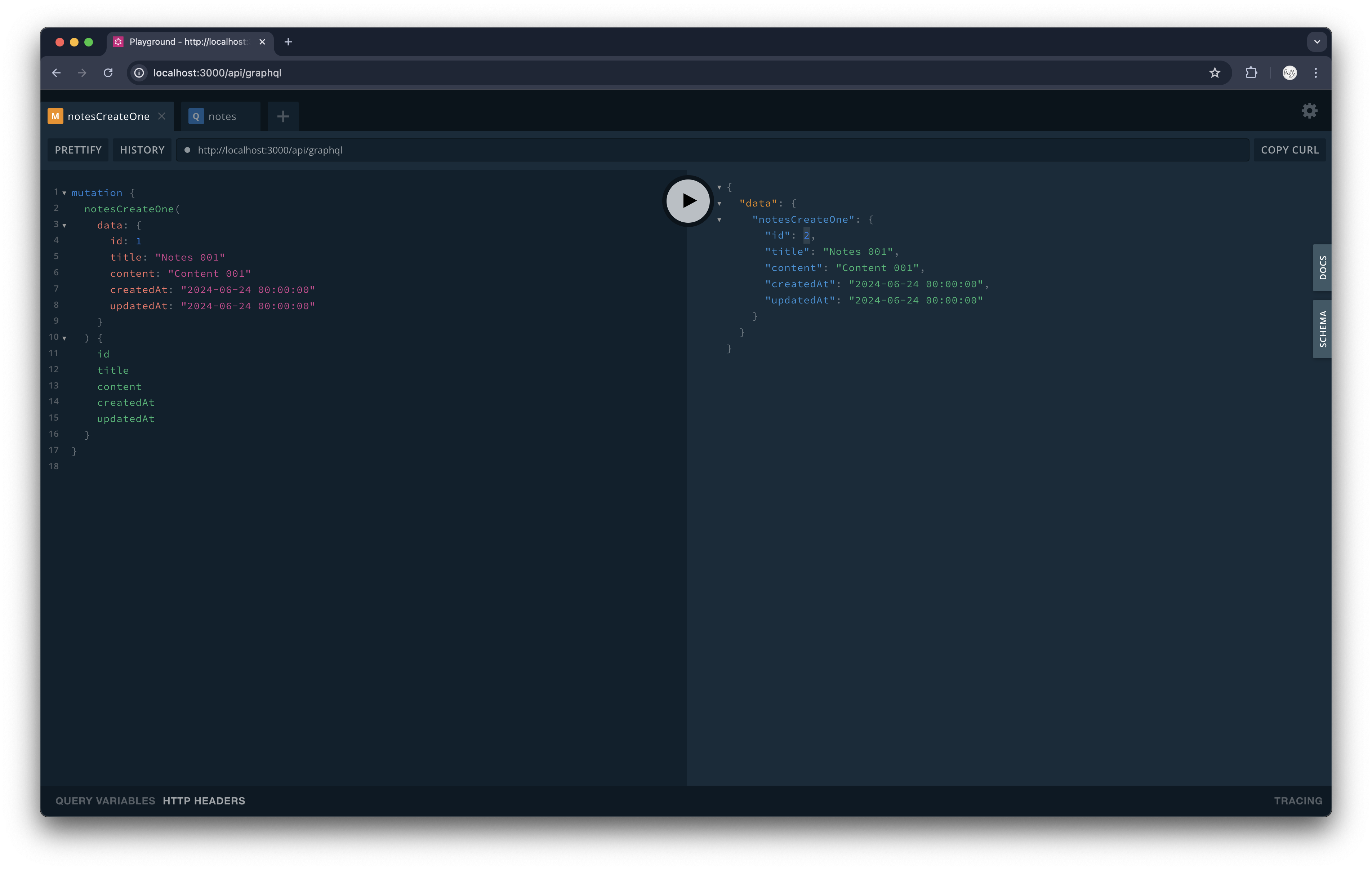
Querying Notes
Query notes with its related files.
query {
notes {
nodes {
id
title
content
files {
nodes {
id
filePath
}
}
}
}
}
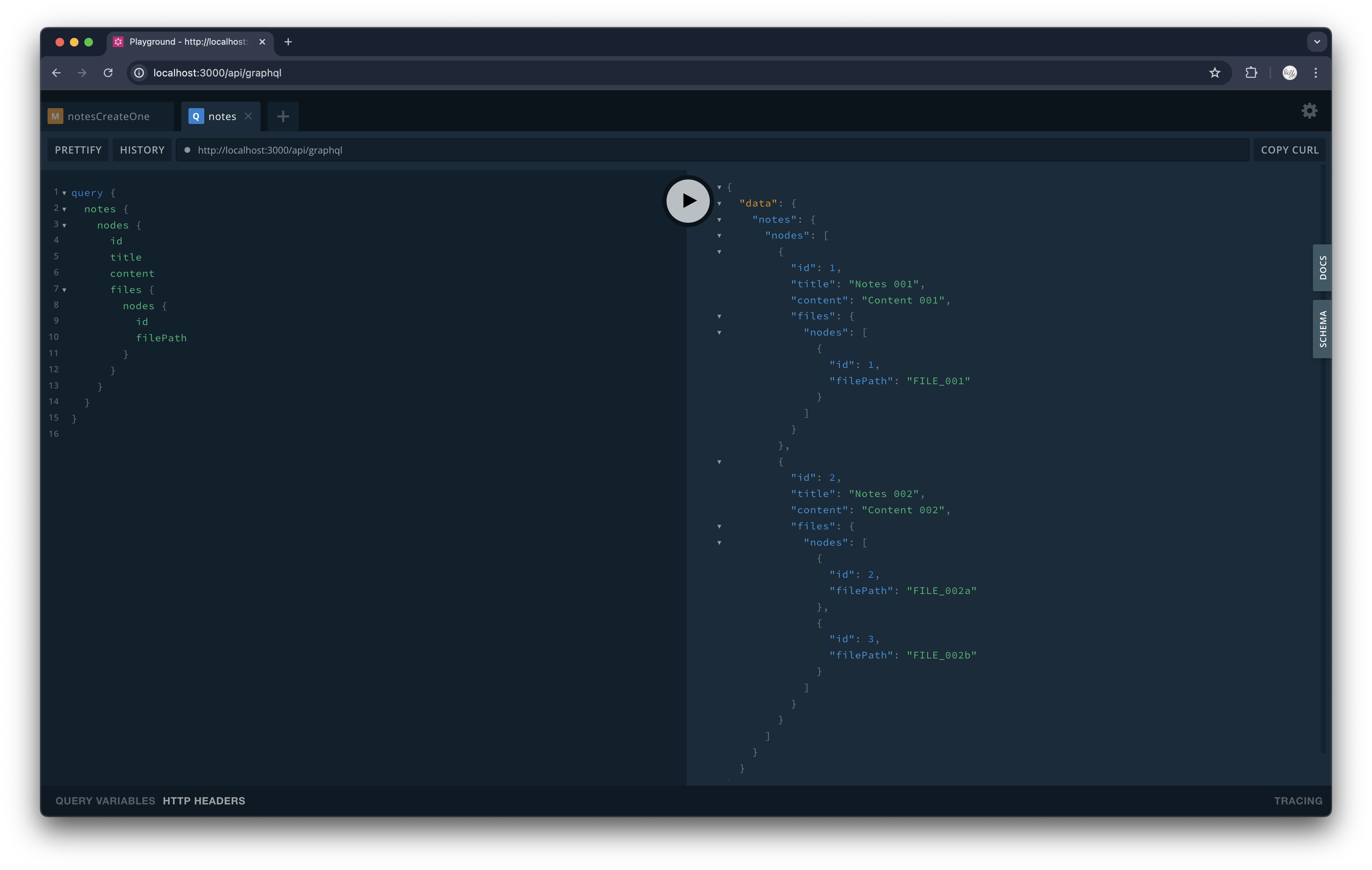
Adding User Authentication to GraphQL Endpoint
Our GraphQL handler can be accessed without user authentication. Next, we want to only allow logged in user to access the GraphQL handler.
To do so, we add _auth: auth::JWT to the graphql_handler function.
async fn graphql_handler(
+ _auth: auth::JWT,
State(ctx): State<AppContext>,
req: Request<Body>,
) -> Result<Response> {
const DEPTH: usize = 10;
const COMPLEXITY: usize = 100;
// Construct the the GraphQL query root
let schema = query_root::schema(ctx.db.clone(), DEPTH, COMPLEXITY).unwrap();
// GraphQL handler
let mut graphql_handler = async_graphql_axum::GraphQL::new(schema);
// Execute GraphQL request and fetch the results
let res = graphql_handler.call(req).await.unwrap();
Ok(res)
}
Then, run the Loco application and visit the GraphQL playground again. You should see unauthorize error.
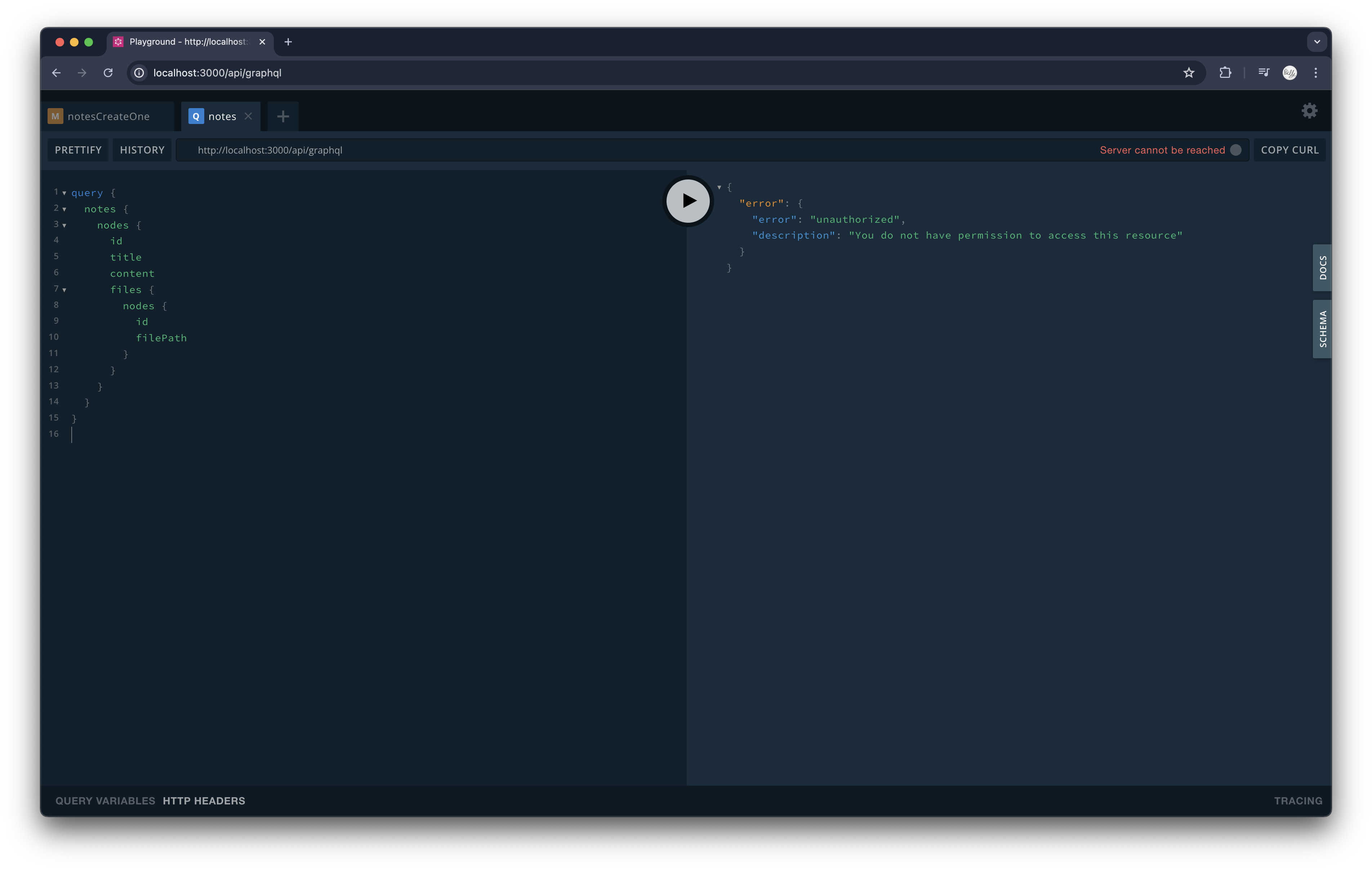
Adding Authentication header to GraphQL Playground
First, we generate a valid authorization token by logging in the user account with the corresponding email and password:
$ curl --location 'http://localhost:3000/api/auth/login' \
--data-raw '{
"email": "cwchan.billy@gmail.com",
"password": "password"
}'
{
"token": "eyJ0eXAiOiJKV1QiLCJhbGciOiJIUzUxMiJ9.eyJwaWQiOiIwN2NjMDk5Ni03YWYxLTQ5YmYtYmY2NC01OTg4ZjFhODM2OTkiLCJleHAiOjE3MTk4MjIzMzN9.CgKp_aE-DyAuBJIvFGJ6l68ooAlEiJGhjWeaetDtHrupaYDm0ldVxf24vj3fPgkCqZ_njv2129n2pSCzHOjaow",
"pid": "07cc0996-7af1-49bf-bf64-5988f1a83699",
"name": "Billy",
"is_verified": true
}
Go to the setting page of GraphQL playground. And add a new header under request. globalHeaders:
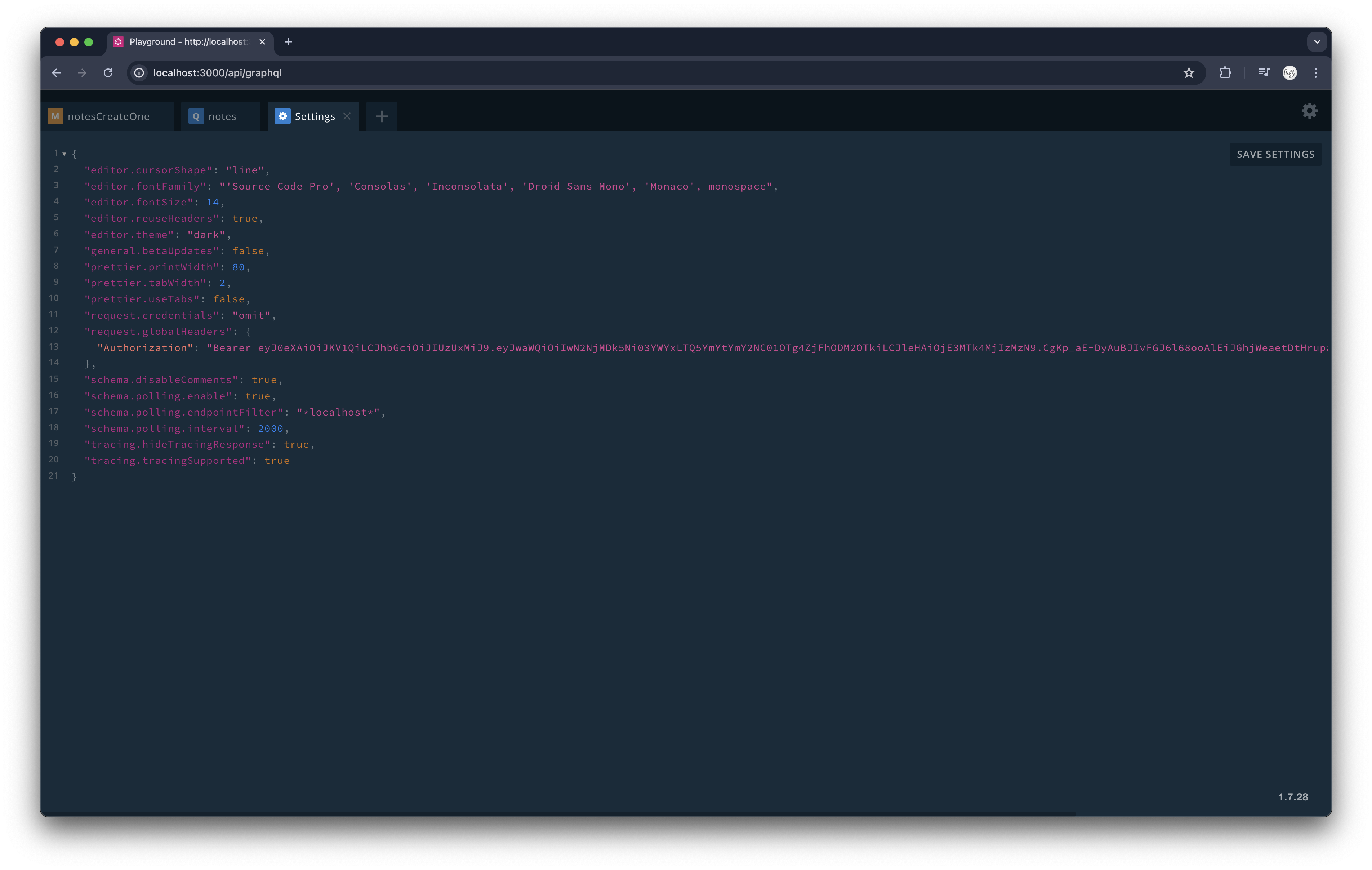
Then, we can access GraphQL handler as usual.

Conclusion
Adding GraphQL support to Loco application is easy with the help of Seaography. It is an ergonomic library that turns SeaORM entities into GraphQL nodes and provides a set of utilities and combined with a code generator makes GraphQL API building a breeze.
SQL Server Support
SQL Server for SeaORM is now available as a closed beta. If you are interested`, please signup here.
Migrating from sea-orm to sea-orm-x is straightforward with two simple steps. First, update the existing sea-orm dependency to sea-orm-x and enable the sqlz-mssql feature. Note that you might need to patch SeaORM dependency for the upstream dependencies.
sea-orm = { path = "<SEA_ORM_X_ROOT>/sea-orm-x", features = ["runtime-async-std-rustls", "sqlz-mssql"] }
sea-orm-migration = { path = "<SEA_ORM_X_ROOT>/sea-orm-x/sea-orm-migration" }
# Patch SeaORM dependency for the upstream dependencies
[patch.crates-io]
sea-orm = { path = "<SEA_ORM_X_ROOT>/sea-orm-x" }
sea-orm-migration = { path = "<SEA_ORM_X_ROOT>/sea-orm-x/sea-orm-migration" }
Second, update the connection string to connect to the MSSQL database.
# If the schema is `dbo`, simply write:
mssql://username:password@host/database
# Or, specify the schema name by providing an extra `currentSchema` query param.
mssql://username:password@host/database?currentSchema=my_schema
# You can trust peer certificate by providing an extra trustCertificate query param.
mssql://username:password@host/database?trustCertificate=true
SeaORM X has full Loco support and integrate seamlessly with many web frameworks:
- Actix
- Axum
- Async GraphQL
- jsonrpsee
- Loco
- Poem
- Salvo
- Tonic
Happy Coding!